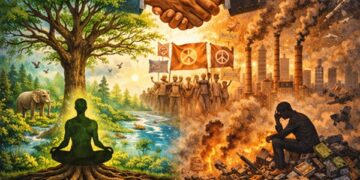Arvind Kejriwal’s rise in Indian politics was nothing short of a revolution. From being an anti-corruption crusader to Delhi’s Chief Minister, he championed governance centered on “freebies” – free electricity, water, healthcare, and education. The Aam Aadmi Party (AAP) branded itself as the messiah of the common man, offering relief from systemic exploitation. However, the very model that elevated Kejriwal to political stardom appears to be the one that has now become his undoing.
With Kejriwal’s recent legal troubles and the decline in AAP’s national appeal, it is worth analyzing whether the culture of freebies is a sustainable governance model or an electoral gimmick with diminishing returns. More importantly, does India, or for that reason any state or union territory, need handouts or genuine structural development?
The Political Utility of Freebies
In the short term, freebies are an excellent electoral strategy. They provide immediate relief to the economically weaker sections, ensuring a loyal voter base. When Kejriwal announced free water, electricity, bus rides for women, and mohalla clinics, it resonated with Delhi’s lower and middle classes.
The idea was simple – reduce people’s monthly expenses, put more money in their pockets, and secure their votes. And it worked. AAP stormed to power in Delhi thrice, each time defeating political giants like the BJP and Congress. The message was clear: people valued tangible benefits over abstract political narratives.
The success of Kejriwal’s model encouraged other politicians to follow suit. From Tamil Nadu’s free grinders and televisions to Telangana’s Rythu Bandhu scheme and Madhya Pradesh’s Ladli Laxmi Yojana, welfare politics became the new norm. Even national parties like BJP and Congress began incorporating similar promises into their manifestos.
But does this welfare-centric approach amount to real development? No. It only indicates desperation on part of leaders to secure votes than any inspiration up their sleeve to execute any development. Announcing freebies is a form of mental bankruptcy and a lack of innovative power to think about how to steer a population out of a conundrum.
The Economic Consequences of Freebies
Freebies are not free. Every rupee given away in subsidies is taken from taxpayers. The Delhi government, for instance, has spent thousands of crores on free electricity and water, while infrastructure projects such as roads, sewage systems, and transport expansions remain underfunded. In these Delhi elections, the taxpaying middle class understood this – albeit a trifle too late.
The consequences of such policies are visible in multiple ways:
First and foremost is the state’s fiscal health. Delhi’s revenue model is unique because it does not rely on agriculture, and its economic backbone is the services sector. However, the AAP government prioritized subsidies over revenue generation.
Then there is an impact on public morale and productivity. Freebies foster a culture of dependency rather than empowerment. When citizens receive basic utilities for free, there is little incentive for them to contribute productively to the economy.
And it cannot be denied that freebie model comes with its own inherent limits. Said that Kejriwal’s ability to disrupt the political landscape was based on his image as a clean politician who delivers. However, as the corruption cases against him mounted, his credibility took a hit.
Then there was his trademark theatrics that only some sensitive and enlightened few could see through.
Theatrics Across His Tenure
- First Term (2013-2014): The Cry baby CM
Kejriwal’s first stint as Delhi’s Chief Minister lasted only 49 days, but it was marked more by melodrama than governance. He frequently wept in public, claiming that the system and vested political interests were obstructing his work. From staging dharnas against the Lieutenant Governor (LG) to accusing every major party of colluding against him, his narrative was built around victimhood. His resignation over the Jan Lokpal Bill, instead of negotiating a practical way forward, set the tone for his “martyr politics,” where he portrayed himself as a lone warrior battling a corrupt system.
- Second Term (2015-2020): The “Muffler Man” vs. Modi
After returning with a massive mandate, Kejriwal turned his theatrics into a direct confrontation with Prime Minister Narendra Modi. From calling the PM a “psychopath” and “coward” to claiming that his phone was being tapped, he constantly positioned himself as the underdog fighting authoritarianism. The “muffler man” image was heavily leveraged, presenting him as a humble, grassroots leader against elite politicians. However, behind the drama, Kejriwal’s governance was increasingly centered on subsidies rather than reforms. His obsession with blaming the Centre for every roadblock in Delhi’s administration was a convenient way to mask his own inefficiencies.
- Third Term (2020-Present): The Freebie Megaphone & Scandal Spiral
Kejriwal’s theatrics evolved into full-fledged populism during his third term. From singing “Hanuman Chalisa” to woo Hindu voters to making exaggerated claims about Delhi’s education model being the “best in the world,” his politics became more about optics than substance. The COVID-19 crisis exposed his governance weaknesses, especially with the infamous “Oxygen Scam,” where Delhi exaggerated oxygen demands. As corruption allegations mounted – especially the liquor policy scandal – he once again played the victim card, claiming that Modi was out to destroy AAP. His recent arrest has been turned into another spectacle, with AAP framing it as a second freedom struggle rather than addressing the core issues of misgovernance and financial irregularities.
Through every phase, Kejriwal has skillfully employed theatrics to maintain his image – whether as a helpless crusader, a defiant opposition leader, or a persecuted victim. However, as real governance challenges mounted, the spectacle appeared to be losing its magic. He, however, thought he was still being magical. And that is what sunk him finally.
Freebies vs. Real Development vs. Populism
India stands at a crossroads. The country needs investments in infrastructure, industry, technology, and education – not just short-term doles. While welfare measures are necessary for social equity, they should not come at the cost of long-term progress. And they should not also come at the expense of a taxpayer’s hard-earned money.
The success of states like Gujarat, Maharashtra, and Karnataka shows that sustained investment in roads, power, industrial corridors, and digital infrastructure yields economic dividends. States that focus on infrastructure attract investments, create jobs, and generate revenue. States that promote freebie culture develop leaders with atrophied brains – a worthless bunch of people who trick people into a bog.
Instead of giving free electricity, governments should ensure 24×7 power supply to industries and small businesses. Rather than providing free bus rides, they should build better public transport networks that can sustain themselves.
Real health reforms involve not just free clinics but well-funded hospitals, medical colleges, and pharmaceutical R&D. Similarly, education reform should focus on curriculum upgrades, teacher training, and digital education – not just infrastructure improvements in government schools.
Welfare should be about enabling people to rise above poverty, not making them dependent on government doles. This requires skill development programs, entrepreneurship support, and business-friendly policies.
Kejriwal’s freebie-driven politics was an experiment that worked in Delhi but is now showing cracks. The country’s economic realities do not allow for perpetual subsidies without strong revenue generation. As India moves towards becoming a global economic powerhouse, its governance models must shift from populist giveaways to real, sustainable development.




